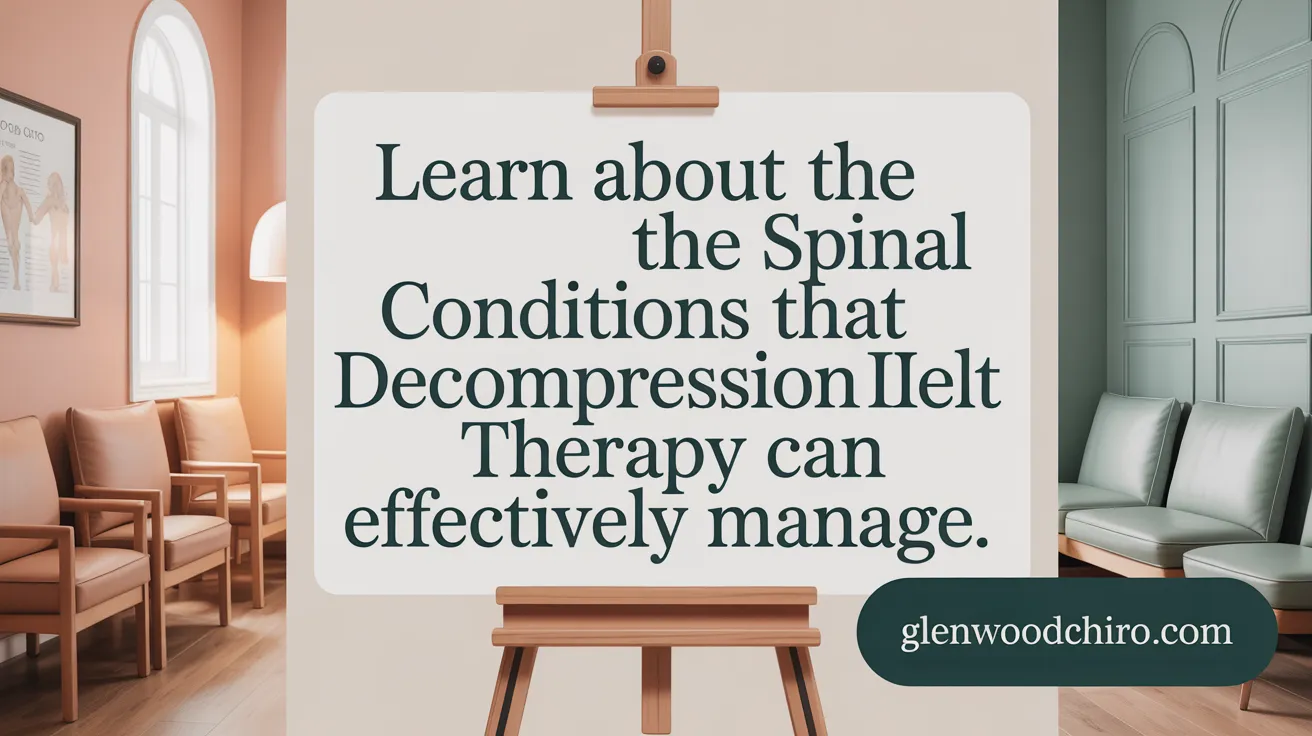Introduction to Spinal Decompression Therapy
Chronic back and nerve pain stemming from conditions like herniated discs, sciatica, and degenerative disc disease affects millions worldwide. Spinal decompression therapy emerges as a promising, non-invasive treatment seeking to alleviate such discomfort by targeting the root causes—compressed nerves and damaged spinal discs. This article explores the mechanisms, benefits, candidate suitability, methods, scientific evidence, risks, and how spinal decompression stands among other treatments for back and nerve pain.
What is Spinal Decompression Therapy and How Does It Work?

Definition and overview of spinal decompression therapy
Spinal decompression therapy is a non-invasive treatment aimed at relieving back and neck pain by gently stretching the spine. This therapy helps reduce pressure on spinal discs and nerves, alleviating symptoms such as sciatica, herniated discs, and degenerative disc disease.
Mechanism of decompression including creation of negative pressure
The core principle of spinal decompression involves creating negative pressure within the affected discs. When the spine is gently stretched using a motorized traction table, this negative pressure acts like a vacuum, helping to retract herniated or bulging disc material back to its proper place. This realignment relieves nerve pressure, reduces pain, and promotes an environment conducive to healing.
Use of specialized motorized traction tables
Advanced equipment, such as the DOC Decompression system, is used in therapy sessions. Patients are positioned on a computer-controlled table fitted with harnesses around the pelvis and trunk. The system carefully maneuvers to elongate and stretch the spine in a controlled manner, ensuring safety and precision. These tables can be adjusted to target specific spinal areas, allowing personalized treatment plans.
Role of nutrient and fluid flow in disc healing
A crucial aspect of decompression therapy is enhancing blood flow, bringing oxygen, water, and nutrients into the damaged discs. This increased circulation helps in nourishing disc tissue, reducing inflammation, and facilitating repair processes. As the discs rehydrate and recover, symptoms like pain and stiffness improve. Learn more about promoting natural healing in discs.
Typical treatment sessions and methodology
Most patients undergo multiple sessions, usually lasting about 30 to 45 minutes each. The therapy involves cycles of gentle stretching and relaxation, with the computer system gradually increasing and decreasing tension. Treatments are often scheduled two to three times weekly over several weeks, depending on individual needs and response. Overall, spinal decompression provides a safe, relaxing, and effective nonsurgical alternative for back pain relief.
Conditions Treatable with Spinal Decompression Therapy
 Spinal decompression therapy is widely recognized for its ability to alleviate symptoms caused by various spinal conditions. The most common ailments include herniated or bulging discs, degenerative disc disease, spinal stenosis, sciatica, and pinched nerves. These conditions often produce back pain, numbness, tingling, weakness in the legs or arms, and difficulty with movement or standing.
Spinal decompression therapy is widely recognized for its ability to alleviate symptoms caused by various spinal conditions. The most common ailments include herniated or bulging discs, degenerative disc disease, spinal stenosis, sciatica, and pinched nerves. These conditions often produce back pain, numbness, tingling, weakness in the legs or arms, and difficulty with movement or standing.
The therapy works by gently stretching the spine to create negative pressure within the discs. This helps retract herniated or bulging disc material, reducing pressure on spinal nerves and decreasing inflammation. As a result, patients often experience relief from pain, improved mobility, and a reduction in nerve irritation.
Non-invasive approaches such as chiropractic care, traction, acupuncture, physical therapy, and nerve stimulation are common first-line treatments and may be used alone or in combination. Surgical options like laminectomy or discectomy are considered when conservative measures fail, but spinal decompression aims to delay or prevent the need for these procedures.
Accurate diagnosis through tests such as MRI, CT scans, and nerve conduction studies is crucial for guiding treatment decisions. These diagnostic tools assess the severity of nerve compression and help tailor personalized treatment plans. Overall, spinal decompression therapy offers a safe, minimally invasive alternative that targets the root causes of back and leg pain stemming from nerve compression.
Benefits of Spinal Decompression Therapy for Disc and Nerve Pain

What are the benefits of spinal decompression therapy for disc and nerve pain?
Spinal decompression therapy provides multiple advantages for those experiencing disc and nerve-related discomfort. Primarily, it offers effective pain relief by alleviating pressure on compressed discs and pinched nerves, which reduces inflammation and helps alleviate symptoms like sciatica, numbness, and tingling.
This therapy promotes improved mobility and spinal alignment. By retracting herniated or bulging discs, it restores the natural position of the spine, thereby enhancing movement and decreasing rigidity.
A significant benefit is the activation of the body's natural healing process. Decompression enhances circulation and increases the flow of oxygen and nutrients to damaged discs, facilitating tissue repair and regeneration.
Unlike surgical options or invasive treatments, spinal decompression is non-invasive and drug-free. It uses gentle mechanical traction on a specialized table, making it safe and comfortable with minimal risk or discomfort during sessions.
Moreover, many patients experience rapid improvement, often noticing reductions in pain within a few therapy sessions. This quick relief can help patients resume normal daily activities sooner.
Another notable advantage is its potential to avoid or delay surgical procedures. For individuals with disc herniation or spinal stenosis, decompression can manage symptoms conservatively, decreasing dependence on medications and reducing overall healthcare costs.
Finally, patient recovery is typically swift, with most able to return to work and routine activities immediately after treatment, making it a practical and appealing option for long-term spinal health.
Scientific Evidence and Effectiveness of Spinal Decompression

What scientific evidence supports the effectiveness of spinal decompression therapy?
Current scientific evidence backing spinal decompression therapy is somewhat limited and often considered low quality. Several small randomized controlled trials (RCTs) and observational studies suggest that the therapy may be effective in reducing disc herniation volume, alleviating pain, and improving functional status. For example, MRI studies have shown significant decreases in herniation size—up to about 27.6% on average—and increased disc height, which indicates some degree of tissue retraction and healing.
In one notable RCT, patients undergoing decompression therapy experienced a higher rate of disc volume reduction compared to control groups, with over a quarter of patients seeing more than a 50% decrease in herniation size. Additionally, patient-reported outcomes, including pain relief and disability scores, tended to improve notably after treatment, with some studies observing benefits lasting at least a year.
However, many of these studies face limitations such as small sample sizes, lack of blinding, and reliance on concurrent treatments like physical therapy or medications, which complicate the attribution of results solely to decompression therapy. Also, some research is funded or published by sources with potential conflicts of interest, raising questions about bias.
Overall, while early evidence appears encouraging and suggests potential benefits, the scientific community agrees that more rigorous, large-scale trials are essential to conclusively evaluate its efficacy. Until then, spinal decompression should be considered a promising but experimental option, with physicians recommending it alongside traditional treatments or after failed conservative therapies.
Risks, Side Effects, and Safety Considerations
 Spinal decompression therapy is generally considered safe when conducted by experienced healthcare providers, involving gentle stretching of the spine with specialized equipment. The most common mild side effects include temporary achiness or muscle soreness post spinal decompression, which can last a few days or weeks. Some patients might experience muscle spasms or minor discomfort that may radiate into the arms or legs, but these are usually manageable and decrease over time.
Spinal decompression therapy is generally considered safe when conducted by experienced healthcare providers, involving gentle stretching of the spine with specialized equipment. The most common mild side effects include temporary achiness or muscle soreness post spinal decompression, which can last a few days or weeks. Some patients might experience muscle spasms or minor discomfort that may radiate into the arms or legs, but these are usually manageable and decrease over time.
Certain conditions can contraindicate the treatment, making thorough screening vital. Patients who are pregnant, have spinal fractures, metal implants, advanced osteoporosis, tumors, or severe nerve damage should avoid decompression therapy unless cleared by their healthcare provider. Other restrictions include those on blood thinners or with spinal instability.
Patient safety is reinforced through careful diagnostic assessments such as MRI or X-ray imaging, ensuring the spine’s condition is suitable for therapy. The treatment generally lasts about 30 minutes per session, with minimal recovery needs afterward. Overall, when proper protocols are followed, the risks associated with spinal decompression are minimal, making it a safe, non-invasive alternative for relieving nerve compression and alleviating back and neck pain.
Procedures and Methods of Spinal Decompression Therapy
What procedures and methods are involved in spinal decompression therapy?
Spinal decompression therapy encompasses both non-surgical spinal decompression and surgical approaches designed to relieve pressure on the spinal nerves. Non-invasive techniques primarily utilize motorized traction systems, such as specialized tables with harnesses to gently stretch the spine. These devices create negative pressure within the spinal discs, encouraging herniated or bulging material to retract and alleviating nerve compression. Treatments are often computer-controlled, allowing for precise adjustments during each session. Complementary non-surgical methods include chiropractic care, physical therapy, acupuncture, and nerve stimulation, all aimed at reducing nerve pressure and supporting natural healing.
When non-surgical methods are insufficient, surgical options may be considered. Procedures like laminectomy, discectomy, foraminotomy, and spinal fusion involve removing or reshaping bone and soft tissue structures that are compressing nerve roots. These surgeries are typically minimally invasive, utilizing small incisions with the goal of decreasing recovery times.
How long do treatments usually last, and how often are sessions scheduled?
A typical course of non-surgical spinal decompression involves multiple sessions, usually 20 to 28 treatments spread over five to seven weeks. Each session lasts approximately 30 to 45 minutes, during which the patient is fitted with harnesses to facilitate gentle traction. Patients often experience relief after a few sessions, with many reporting improvements in pain and mobility.
What surgical options exist for more severe cases?
In cases where conservative treatment fails, surgical options are considered. These include discectomy (removal of herniated disc material), laminectomy (removing part of the vertebral bone to enlarge the spinal canal), foraminotomy (widening the nerve root openings), and osteophyte removal (eliminating bone spurs). In more complex cases, spinal fusion may be performed to stabilize adjacent vertebrae.
How is treatment choice guided?
Diagnostic imaging such as MRI, CT scans, and X-rays play a crucial role in assessing the severity and exact location of nerve compression or disc damage. This information guides clinicians in selecting the most appropriate intervention, whether conservative or surgical.
Stepwise approach from conservative to surgical intervention
Most treatment plans follow a stepped approach, starting with non-invasive therapies aimed at alleviating symptoms and promoting healing. If these methods do not provide adequate relief, minimally invasive surgeries are then considered. Surgery becomes the last resort, especially in cases of severe nerve compression or structural abnormalities, to ensure the most effective outcome with minimal risk.
Comparing Spinal Decompression with Other Treatment Options
Spinal decompression therapy is a targeted, non-invasive treatment that aims to relieve disc-related nerve pain by gently stretching the spine and promoting disc healing. It has demonstrated effectiveness comparable to traditional traction therapy, with some studies indicating success rates between 71% and 89%. Compared to conventional conservative treatments such as physical therapy, medications, and injections, decompression may provide more direct and rapid relief for conditions like herniated discs, sciatica, and degenerative disc disease.
One significant advantage of decompression over medication is its non-surgical, drug-free pain relief, reducing the risk of side effects associated with painkillers or anti-inflammatory drugs. Many patients appreciate that because it provides relief without the need for surgery or medication. It is also regarded as beneficial in potentially avoiding or delaying the need for invasive surgical procedures, especially for patients with moderate symptoms who are candidates for non-surgical options.
However, despite promising outcomes, the scientific evidence supporting the long-term efficacy of spinal decompression therapy remains limited and somewhat inconclusive. Most studies have methodological limitations, and more rigorous, large-scale research is needed to fully establish its benefits. For more on this, see limitations of spinal decompression studies.
Cost is another consideration, as decompression therapy can be expensive—unit prices range from several thousand to over $100,000 for specialized equipment, and treatments often require multiple sessions, raising questions about accessibility and affordability as noted in sources like spinal decompression therapy costs.
Ultimately, individualized treatment planning and consultation with qualified healthcare professionals are essential. Proper patient selection and a comprehensive diagnosis are crucial to determine whether decompression therapy is appropriate and likely to be effective in managing back pain symptoms. For guidance, see consulting healthcare providers for back pain.
Summary: The Promise and Considerations of Spinal Decompression Therapy
Spinal decompression therapy represents a compelling, non-invasive option for patients struggling with disc and nerve pain associated with herniated discs, sciatica, and degenerative spinal conditions. By gently stretching the spine and promoting nutrient-rich fluid flow into damaged discs, it offers potential pain relief, improved mobility, and a way to avoid or delay surgery. Despite encouraging patient reports and preliminary studies suggesting reductions in disc herniation and pain improvement, the scientific evidence currently remains limited and calls for more rigorous research to validate long-term efficacy. Safety profiles are generally favorable with careful patient selection, although some mild side effects and contraindications exist. Ultimately, spinal decompression can be an effective part of a comprehensive treatment plan individualized to patient needs, complementing traditional therapies while providing a drug-free, non-surgical approach to spinal health and pain management.
